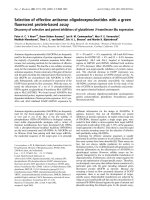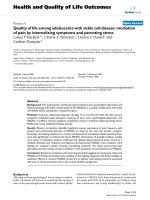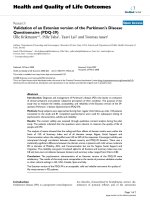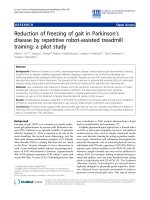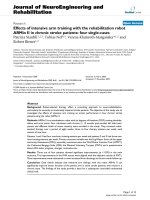Báo cáo hóa học: "ˇ ˇ VARIANTS OF CEBYSEV’S INEQUALITY WITH APPLICATIONS" potx
Bạn đang xem bản rút gọn của tài liệu. Xem và tải ngay bản đầy đủ của tài liệu tại đây (542.82 KB, 13 trang )
VARIANTS OF
ˇ
CEBY
ˇ
SEV’S INEQUALITY
WITH APPLICATIONS
M. KLARI
ˇ
CI
´
C BAKULA, A. MATKOVI
´
C, AND J. PE
ˇ
CARI
´
C
Received 19 December 2005; Accepted 2 April 2006
Several variants of
ˇ
Ceby
ˇ
sev’s inequality for two monotonic n-tuples and also k
≥ 3non-
negative n-tuples monotonic in the same direction are presented. Immediately after that
their refinements of Ostrowski’s type are given. Obtained results are used to prove gen-
eralizations of discrete Milne’s inequality and its converse in which weights satisfy condi-
tions as in the Jensen-Steffensen inequality.
Copyright © 2006 M. Klari
ˇ
ci
´
c Bakula et al. This is an open access article distr i buted un-
der the Creative Commons Attribution License, which permits unrestricted use, distri-
bution, and reproduction in any medium, provided the original work is properly cited.
1. Introduction
In 2003 Mercer gave the following interesting variant of the discrete Jensen’s inequality
(see, e.g., [8, page 43]) for convex functions.
Theorem 1.1 [4,Theorem1]. If f is a convex function on an interval containing n-tuple
x
= (x
1
, ,x
n
) such that 0 <x
1
≤ x
2
≤ ··· ≤ x
n
and w = (w
1
, ,w
n
) is positive n-tuple
with
n
i
=1
w
i
= 1, then
f
x
1
+ x
n
−
n
i=1
w
i
x
i
≤
f
x
1
+ f
x
n
−
n
i=1
w
i
f
x
i
. (1.1)
Two years later his result was generalized as it is stated below.
Theorem 1.2 [1,Theorem2]. Let [a, b] be an interval in
R, a<b.Letx = (x
1
, ,x
n
) be a
monotonic n-tuple in [a,b]
n
,andletw = (w
1
, ,w
n
) bearealn-tuple such that
0
≤ W
k
≤ W
n
(k = 1, ,n − 1), W
n
> 0,
(1.2)
Hindawi Publishing Corporation
Journal of Inequalities and Applications
Volume 2006, Article ID 39692, Pages 1–13
DOI 10.1155/JIA/2006/39692
2 Variants of
ˇ
Ceby
ˇ
sev’s inequality with applications
where W
k
=
k
i
=1
w
i
(k = 1, ,n).Iffunction f :[a,b] → R is convex, then
f
a + b −
1
W
n
n
i=1
w
i
x
i
≤
f (a)+ f (b) −
1
W
n
n
i=1
w
i
f
x
i
. (1.3)
As we can see, here the condition w
i
> 0(i = 1, ,n) is relaxed on the conditions (1.2)
as in the well-known Jensen-Steffensen inequality for sums (see, e.g, [8, page 57]).
Remark 1.3. It can be easily proved that for a real n-tuple w which satisfies (1.2)andfor
any monotonic n-tuple x
∈ [a,b]
n
the inequalities
a
≤
1
W
n
n
i=1
w
i
x
i
≤ b, (1.4)
hold. From (1.4) we can also conclude that a + b
−
1
W
n
n
i
=1
w
i
x
i
∈ [a,b].
In this paper we present “Mercer’s type” variants of several well-known inequalities.
In Section 2 we give generalizations of the discrete
ˇ
Ceby
ˇ
sev’s inequality for two mono-
tonic n-tuples and also for k
≥ 3 nonnegative n-tuples monotonic in the same direction,
in which weig hts w satisfy the conditions (1.2). Immediately after Mercer’s type variants
of those inequalities are presented. In Section 3 we give analogous variants of Pe
ˇ
cari
´
c’s
generalizations of the discrete Ostrowski’s inequalities. In Section 4 we use results from
Section 2 to obtain generalizations of Milne’s inequality and its converse. Mercer’s type
variants of Milne’s inequality and its converse are also given.
2. Variants of
ˇ
Ceby
ˇ
sev’s inequality
A classic result due to
ˇ
Ceby
ˇ
sev (1882, 1883) is stated as follows. Let w be a nonnegative
n-tuple. If real n-tuples x
= (x
1
, ,x
n
)andy = (y
1
, , y
n
) are monotonic in the same
direction, then
n
i=1
w
i
x
i
n
i=1
w
i
y
i
≤
n
i=1
w
i
n
i=1
w
i
x
i
y
i
. (2.1)
If x and y are monotonic in opposite directions, the inequality (2.1)isreversed.
Although the proof of the following generalization of the inequality (2.1)hasbeen
already known (see [6]) for the sake of clarity, we will briefly present it here.
Theorem 2.1. Let w
= (w
1
, ,w
n
) be a real n-tuple such that (1.2) is satisfied. Then for any
real n-tuples x
= (x
1
, ,x
n
), y = (y
1
, , y
n
) monotonic in the same direction the inequality
(2.1) holds. If x and y are monotonic in opposite directions, (2.1)isreversed.
Proof. Using the well-known Abel’s identity it can be proved that the following identity
holds:
n
i=1
w
i
n
i=1
w
i
x
i
y
i
−
n
i=1
w
i
x
i
n
i=1
w
i
y
i
=
n−1
k=1
⎡
⎣
k−1
l=1
W
k+1
W
l
x
l+1
− x
l
y
k+1
− y
k
+
n
l=k+1
W
l
W
k
x
l
− x
l−1
y
k+1
− y
k
⎤
⎦
,
(2.2)
M. Klari
ˇ
ci
´
c Bakula et al. 3
where
W
k
=
n
i
=k
w
i
. Suppose that x and y are monotonic in the same direction. Then
x
i+1
− x
i
y
j+1
− y
j
≥
0 (2.3)
for all i, j
∈{1, ,n − 1}. Furthermore, the conditions (1.2)onn-tuple w imply that also
W
k
≥ 0(k = 1, ,n), (2.4)
so from identity (2.2) we may conclude that
n
i=1
w
i
n
i=1
w
i
x
i
y
i
−
n
i=1
w
i
x
i
n
i=1
w
i
y
i
≥ 0. (2.5)
If x and y are monotonic in opposite directions, we have
x
i+1
− x
i
y
j+1
− y
j
≤
0 (2.6)
for all i, j
∈{1, ,n − 1},sothereverseof(2.1) immediately follows.
This completes the proof.
In the next theorem we give a Mercer’s type variant of the inequality (2.1).
Theorem 2.2. Let n
≥ 2 and let w be a real n-tuple such that (1.2)issatisfied.Let[a,b]
and [c,d] be intervals in
R,wherea<b, c<d. Then for any real n-tuples x ∈ [a,b]
n
and
y
∈ [c,d]
n
monotonic in the same direction,
a + b −
1
W
n
n
i=1
w
i
x
i
c + d −
1
W
n
n
i=1
w
i
y
i
≤
ac + bd −
1
W
n
n
i=1
w
i
x
i
y
i
. (2.7)
If x and y are monotonic in opposite directions, the inequality (2.7)isreversed.
Proof. Without any loss of generality we may suppose that n-tuples x and y are both
monotonically decreasing (in other cases the proof is similar). We define (n +2)-tuples
w
= (w
1
, ,w
n+2
), x
= (x
1
, ,x
n+2
), and y
= (y
1
, , y
n+2
)as
w
1
= 1, w
2
=−
w
1
W
n
, ,w
n+1
=−
w
n
W
n
, w
n+2
= 1,
x
1
= b, x
2
= x
1
, ,x
n+1
= x
n
, x
n+2
= a,
y
1
= d, y
2
= y
1
, , y
n+1
= y
n
, y
n+2
= c.
(2.8)
Obviously, x
and y
are both monotonically decreasing and we have
0
≤ W
k
≤ 1(k = 1, ,n +1), W
n+2
= 1, (2.9)
so we may apply Theorem 2.1 on (n +2)-tuplesw
, x
,andy
to obtain
n+2
i=1
w
i
x
i
n+2
i=1
w
i
y
i
≤
n+2
i=1
w
i
n+2
i=1
w
i
x
i
y
i
(2.10)
from which we can easily get (2.7).
4 Variants of
ˇ
Ceby
ˇ
sev’s inequality with applications
ˇ
Ceby
ˇ
sev’s inequality can be generalized for k
≥ 3 nonnegative n-tuples monotonic in
the same direction with nonnegative weights w (see, e.g., [8, page 198]). Here we give an
analogous generalization of
ˇ
Ceby
ˇ
sev’s inequality for k
≥ 3 nonnegative n-tuples in which
weights w satisfy the conditions (1.2). Partial order “
≤”onR
k
here is defined as
x
1
, ,x
k
≤
y
1
, , y
k
⇐⇒
x
1
≤ y
1
∧···∧x
k
≤ y
k
. (2.11)
In order to simplify our results, we will consider only weights w with sum 1.
Theorem 2.3. Let n
≥ 2 and let w be a real n-tuple such that
0
≤ W
k
≤ 1(k = 1, ,n − 1), W
n
= 1. (2.12)
Let k
≥ 2 and let I ⊆ [0,+∞
k
. Then for any x
(1)
, ,x
(n)
∈ I such that
x
(1)
≤··· ≤ x
(n)
or x
(1)
≥···≥ x
(n)
, (2.13)
the following holds:
k
i=1
n
j=1
w
j
x
(j)
i
≤
n
j=1
w
j
k
i=1
x
(j)
i
. (2.14)
Proof. The proof of (2.14) is by induction on k. T he case k
= 2followsfromTheorem 2.1.
Suppose that (2.14)isvalidforalll,2
≤ l ≤ k.Wehave
n
j=1
w
j
k+1
i=1
x
(j)
i
=
n
j=1
w
j
k
i=1
x
(j)
i
x
(j)
k+1
, (2.15)
and we know that
k
i=1
n
j=1
w
j
x
(j)
i
≥ 0,
n
j=1
w
j
k
i=1
x
(j)
i
≥ 0,
n
j=1
w
j
x
(j)
k+1
≥ 0 (2.16)
(see Remark 1.3). We define nonnegative n-tuple y as
y
j
=
k
i=1
x
(j)
i
(j = 1, ,n). (2.17)
It can be easily seen that y is monotonic in the same sense as (x
(1)
, ,x
(n)
), that is, y is
monotonic in the same sense as (x
(1)
k+1
, ,x
(n)
k+1
), so we may apply (2.1) and our induction
hypothesis in (2.15)toobtain
n
j=1
w
j
k+1
i=1
x
(j)
i
=
n
j=1
w
j
k
i=1
x
(j)
i
x
(j)
k+1
≥
⎛
⎝
n
j=1
w
j
k
i=1
x
(j)
i
⎞
⎠
⎛
⎝
n
j=1
w
j
x
(j)
k+1
⎞
⎠
≥
⎛
⎝
k
i=1
n
j=1
w
j
x
(j)
i
⎞
⎠
⎛
⎝
n
j=1
w
j
x
(j)
k+1
⎞
⎠
=
k+1
i=1
n
j=1
w
j
x
(j)
i
,
(2.18)
so by induction the result holds.
M. Klari
ˇ
ci
´
c Bakula et al. 5
In the next theorem we give a Mercer’s type variant of (2.14).
Theorem 2.4. Let n
≥ 2 and let w bearealn-tuple such that (2.12)issatisfied.Letk ≥ 2
and let I
= [a
1
,b
1
] ×···×[a
k
,b
k
] ⊂ [0,+∞
k
.Thenforanyx
(1)
, ,x
(n)
∈ I such that
x
(1)
≤··· ≤ x
(n)
or x
(1)
≥···≥ x
(n)
, (2.19)
the following holds:
k
i=1
a
i
+ b
i
−
n
j=1
w
j
x
(j)
i
≤
k
i=1
a
i
+
k
i=1
b
i
−
n
j=1
w
j
k
i=1
x
(j)
i
. (2.20)
Proof. Suppose that x
(1)
≤ ··· ≤x
(n)
.Wedefinevectorsξ
(j)
∈ [0,+∞
k
(j = 1, ,n +2)
and weights w
as
ξ
(1)
i
= a
i
, ξ
(n+2)
i
= b
i
(i = 1, ,k),
ξ
(j)
= x
(j−1)
(j = 2, ,n +1),
w
1
= 1, w
2
=−w
1
, ,w
n+1
= w
n
, w
n+2
= 1.
(2.21)
Obviously, we have ξ
(1)
≤··· ≤ ξ
(n+2)
and
0
≤ W
k
≤ 1(k = 1, ,n +1), W
n+2
= 1. (2.22)
We can apply Theorem 2.3 on ξ
(j)
(j = 1, ,n +2)andw
to obtain
k
i=1
n+2
j=1
w
j
ξ
(j)
i
≤
n+2
j=1
w
n+2
j
w
j
k
i=1
ξ
(j)
i
, (2.23)
from which (2.20) immediately follows. If x
(1)
≥··· ≥ x
(n)
, the proof is similar.
3. Variants of Pe
ˇ
cari
´
c’s inequalities
In 1984 Pe
ˇ
cari
´
c proved several generalizations of the discrete Ostrowski’s inequalities.
Here we give two of them which are interesting to us because they are refinements of
Theorem 2.1.
Theorem 3.1 [7,Theorem3]. Let x
= (x
1
, ,x
n
) and y = (y
1
, , y
n
) be real n-tuples
monotonic in the same direction and let w
= (w
1
, ,w
n
) be a real n-tuple such that
0
≤ W
k
≤ W
n
(k = 1, ,n − 1). (3.1)
If m and r are nonnegative real numbers such that
x
k+1
− x
k
≥
m,
y
k+1
− y
k
≥
r (k = 1, ,n − 1), (3.2)
then
T(x,y;w)
≥ mrT(e,e;w) ≥ 0, (3.3)
6 Variants of
ˇ
Ceby
ˇ
sev’s inequality with applications
where
T(x,y;w)
=
n
i=1
w
i
n
i=1
w
i
x
i
y
i
−
n
i=1
w
i
x
i
n
i=1
w
i
y
i
,
e
= (0,1, ,n − 1).
(3.4)
If x and y are monotonic in opposite directions, then
T(x,y;w)
≤−mrT(e,e;w) ≤ 0. (3.5)
Theorem 3.2 [7,Theorem4]. Let x and y be real n-tuples such that
x
k+1
− x
k
≤
M,
y
k+1
− y
k
≤
R (k = 1, ,n − 1) (3.6)
hold for some nonnegative real numbers M and R,andletw bearealn-tuple such that (3.1)
is valid. Then
T(x,y;w)
≤
MRT(e,e;w). (3.7)
In the next two theorems we give Mercer’s type variants of Theorems 3.1 and 3.2 which
are refinements of Theorem 2.2.
Theorem 3.3. Let n
≥ 2 and let w be a real n-tuple such that (2.12)isvalid.Let[a,b], [c,d]
be intervals in
R,wherea<b, c<d.Letx= (x
1
, ,x
n
) ∈ [a,b]
n
and y= (y
1
, , y
n
) ∈ [c,d]
n
be monotonic n-tuples, and let m and r be nonnegative real numbers such that
min
1≤i≤n
x
i
− a ≥ m, b − max
1≤i≤n
x
i
≥ m,
x
k+1
− x
k
≥
m (k = 1, ,n − 1),
min
1≤i≤n
y
i
− c ≥ r, d − max
1≤i≤n
y
i
≥ r,
y
k+1
− y
k
≥
r (k = 1, ,n − 1).
(3.8)
If x and y are monotonic in the same direction, then
T(x,y;w) ≥ mr
T(f,f;w)+2n
≥
0, (3.9)
where
T(x,y;w) = ac + bd −
n
i=1
w
i
x
i
y
i
−
a + b −
n
i=1
w
i
x
i
c + d −
n
i=1
w
i
y
i
,
f
= (1, ,n) ∈ [1,n]
n
.
(3.10)
If x and y are monotonic in opposite directions, then
T(x,y;w) ≤−mr
T(f,f;w)+2n
≤
0. (3.11)
M. Klari
ˇ
ci
´
c Bakula et al. 7
Proof. Suppose that n-tuples x and y are both monotonically decreasing (if x and y are
monotonically increasing, the proof is similar). We define (n +2)-tuples w
= (w
1
, ,
w
n+2
), x
= (x
1
, ,x
n+2
), and y
= (y
1
, , y
n+2
)as
w
1
= 1, w
2
=−w
1
, ,w
n+1
=−w
n
, w
n+2
= 1,
x
1
= b, x
2
= x
1
, ,x
n+1
= x
n
, x
n+2
= a,
y
1
= d, y
2
= y
1
, , y
n+1
= y
n
, y
n+2
= c.
(3.12)
Obviously, x
and y
are both monotonically decreasing and we have
0
≤ W
k
≤ 1(k = 1, ,n +1), W
n+2
= 1,
x
k+1
− x
k
≥
m,
y
k+1
− y
k
≥
r (k = 1, ,n +1).
(3.13)
From Theorem 3.1 we have
T(x
,y
;w
) ≥ mrT(e
,e
;w
) ≥ 0, (3.14)
where
e
= (0,1, ,n +1). (3.15)
From that we immediately obtain
ac + bd
−
n
i=1
w
i
x
i
y
i
−
a + b −
n
i=1
w
i
x
i
c + d −
n
i=1
w
i
y
i
≥
mr
⎡
⎣
n+2
i=1
w
i
(i − 1)
2
−
n+2
i=1
w
i
(i − 1)
2
⎤
⎦
=
mr
⎡
⎣
(n +1)
2
−
n
i=1
w
i
i
2
−
n +1−
n
i=1
w
i
i
2
⎤
⎦
≥
0,
(3.16)
that is,
T(x,y;w) ≥ mr
T(f,f;w)+2n
≥
0. (3.17)
If n-tuples x and y are monotonic in opposite directions, the proof is similar.
Theorem 3.4. Let n ≥ 2 and let w be a real n-tuple such that (2.12)isvalid.Let[a,b], [c,d]
be intervals in
R,wherea<b, c<d.Letx = (x
1
, ,x
n
) ∈ [a,b]
n
, y = (y
1
, , y
n
) ∈ [c,d]
n
and let M and R be nonnegative real numbers such that
x
1
− a
≤
M,
b − x
n
≤
M,
x
k+1
− x
k
≤
M (k = 1, ,n − 1),
y
1
− c
≤
R,
d − y
n
≤
R,
y
k+1
− y
k
≤
R (k = 1, ,n − 1).
(3.18)
8 Variants of
ˇ
Ceby
ˇ
sev’s inequality with applications
Then
T(x,y;w)
≤
MR
T(f,f;w)+2n
≤
0. (3.19)
Proof. Similarly as in Theorem 3.3.
Corollary 3.5. Let n ≥ 2 and let [a,b] be an interval in R where a<b.Thenforallx =
(x
1
, ,x
n
) ∈ [a,b]
n
,
⎡
⎣
na
2
+ nb
2
−
n
i=1
x
2
i
−
1
n
na + nb −
n
i=1
x
i
2
⎤
⎦
12
n(n + 1)(5n +7)
≥ m
2
, (3.20)
where
m
= min
0≤i<j≤n+1
x
i
− x
j
, x
0
= a, x
n+1
= b. (3.21)
Proof. Directly from Theorem 3.3.
Corollary 3.6. Let x = (x
1
, ,x
n
), y = (y
1
, , y
n
), M and R be defined as in Theorem 3.4.
Then
nac + nbd −
n
i=1
x
i
y
i
−
1
n
na + nb −
n
i=1
x
i
nc + nd −
n
i=1
y
i
≤
n(n + 1)(5n +7)
12
MR.
(3.22)
Proof. Directly from Theorem 3.4.
The above results are variants of some Lupas¸’ results [3].
4. Applications: inequality of Milne and its converse
In 1925 Milne [5] obtained the following interesting integral inequality for positive func-
tions f and g which are integrable on [a,b]:
b
a
f (x)g(x)
f (x)+g(x)
dx
b
a
f (x)+g(x)
dx ≤
b
a
f (x)dx
b
a
g(x)dx. (4.1)
In 2000 Rao [9] combined Milne’s inequality and the well-known inequality between
arithmetic and geometric means to obtain the following double inequality for sums.
Proposition 4.1. Let n
≥ 2 and let w
i
> 0(i = 1,2, ,n) be real numbers with
n
i
=1
w
i
= 1.
Then for all real numbers p
i
∈−1,1 (i = 1, ,n),
n
i=1
w
i
1 − p
2
i
≤
n
i=1
w
i
1 − p
i
n
i=1
w
i
1+p
i
≤
n
i=1
w
i
1 − p
2
i
2
. (4.2)
Two years later Alzer and Kova
ˇ
cec obtained the following refinement of (4.2).
M. Klari
ˇ
ci
´
c Bakula et al. 9
Theorem 4.2 [2,Theorem1]. Let n
≥ 2 and let w
i
> 0(i = 1,2, ,n) be real numbers with
n
i
=1
w
i
= 1. Then for all real numbers p
i
∈ [0,1 (i = 1, ,n),
n
i=1
w
i
1 − p
2
i
α
≤
n
i=1
w
i
1 − p
i
n
i=1
w
i
1+p
i
≤
n
i=1
w
i
1 − p
2
i
β
(4.3)
w ith the best possible exponents
α
= 1, β = 2 − min
1≤i≤n
w
i
. (4.4)
We note here that the crucial step in the proof of Theorem 4.2 was performed by using
a discrete variant of the
ˇ
Ceby
ˇ
sev’s inequality (see, e.g., [8, page 197]) which itself was gen-
eralized in Section 2. This enables us to give the following generalization of Theorem 4.2.
Theorem 4.3. Let n
≥ 2 and let w = (w
1
, ,w
n
) be a real n-tuple such that (2.12)issat-
isfied. Then for all α
∈−∞,1], β ∈ [2 − min
1≤i≤n
W
i
,+∞ and for all monotonic n-tuples
p
= (p
1
, , p
n
) ∈ [0,1
n
,
n
i=1
w
i
1 − p
2
i
α
≤
n
i=1
w
i
1 − p
i
n
i=1
w
i
1+p
i
≤
n
i=1
w
i
1 − p
2
i
β
(4.5)
w ith the best possible exponents
α
= 1, β = 2 − min
1≤i≤n
W
i
. (4.6)
Proof. Wefollowtheideaoftheproofgivenin[2]. Suppose that 1 >p
1
≥ p
2
≥ ··· ≥
p
n
≥ 0. It can be easily seen that
0 <
1
1+p
1
≤
1
1+p
2
≤··· ≤
1
1+p
n
≤ 1,
1
1 − p
1
≥
1
1 − p
2
≥··· ≥
1
1 − p
n
≥ 1,
1
1 − p
2
1
≥
1
1 − p
2
2
≥··· ≥
1
1 − p
2
n
≥ 1,
(4.7)
so in this case (see Remark 1.3)weknowthat
n
i=1
w
i
1 − p
i
≥ 1,
n
i=1
w
i
1+p
i
> 0,
n
i=1
w
i
1 − p
2
i
≥ 1. (4.8)
Let w
= min
1≤i≤n
W
i
. We define function f :[0,1
n
→ R as
f
p
1
, , p
n
=
(2 − w)log
n
i=1
w
i
1 − p
2
i
−
log
n
i=1
w
i
1 − p
i
−
log
n
i=1
w
i
1+p
i
.
(4.9)
For fixed k
∈{1, ,n − 1} we define function f
k
:[0,1→R as
f
k
(p) = f
p, , p, p
k+1
, , p
n
. (4.10)
10 Variants of
ˇ
Ceby
ˇ
sev’s inequality with applications
Let p
∈ [p
k+1
,1.Wehave
f
k
(p) =
W
k
D
1 − p
2
ABC
, (4.11)
where
A
= W
k
+
n
i=k+1
w
i
1 − p
2
1 − p
2
i
, B = W
k
+
n
i=k+1
w
i
1 − p
1 − p
i
, C = W
k
+
n
i=k+1
w
i
1+p
1+p
i
,
(4.12)
D
= A
(1 − p)B − (1 + p)C
+2(2− w)pBC. (4.13)
We define n-tuples x
= (x
1
, ,x
n
)andy = (y
1
, , y
n
)with
x
i
= 1, y
i
= 1(i = 1, ,k),
x
i
=
1 − p
1 − p
i
, y
i
=
1+p
1+p
i
(i = k +1, ,n),
(4.14)
which are obviously monotonic in opposite directions. From Theorem 2.1 we have
n
i=1
w
i
x
i
n
i=1
w
i
y
i
≥
n
i=1
w
i
x
i
y
i
, (4.15)
that is, BC
≥ A,andfromRemark 1.3 we know that A, B,andC are all positive. This
enables us to conclude that
D
A
≥ (1− p)B − (1 + p)C +2(2− w)p
= 2p
2 − w − W
k
+
n
i=k+1
w
i
(1 − p)
2
1 − p
i
−
(1 + p)
2
1+p
i
.
(4.16)
It can be easily seen that
−4p = (1 − p)
2
− (1 + p)
2
≤
(1 − p)
2
1 − p
k+1
−
(1 + p)
2
1+p
k+1
≤···≤
(1 − p)
2
1 − p
n
−
(1 + p)
2
1+p
n
,
(4.17)
so we have
k
i=1
w
i
(−4p)+
n
i=k+1
w
i
(1 − p)
2
1 − p
i
−
(1 + p)
2
1+p
i
≥−
4p, (4.18)
that is,
n
i=k+1
w
i
(1 − p)
2
1 − p
i
−
(1 + p)
2
1+p
i
≥−4p +4pW
k
. (4.19)
M. Klari
ˇ
ci
´
c Bakula et al. 11
From (4.19)and(4.16)weobtain
D
A
≥ 2p
W
k
− w
≥
0, (4.20)
which implies that the function f
k
is increasing on [p
k+1
,1. Using that fact we obtain
f
p
1
, , p
n
=
f
1
p
1
≥
f
1
p
2
=
f
2
p
2
≥
f
2
p
3
=
f
3
p
3
≥··· ≥
f
n−1
p
n
=−
(1 − w)log
1 − p
2
n
≥
0,
(4.21)
which implies
n
i=1
w
i
1 − p
i
n
i=1
w
i
1+p
i
≤
n
i=1
w
i
1 − p
2
i
2−w
, (4.22)
that is, the right inequality in (4.5)holdsforβ
= 2− min
1≤i≤n
W
i
.Since
n
i=1
w
i
1 − p
2
i
≥ 1, (4.23)
it is clear that it also holds for all β
≥ 2− min
1≤i≤n
W
i
.
A similar argument as in [2] shows that β
= 2 − min
1≤i≤n
W
i
gives the best upper
bound in (4.5): if W
k
= min
1≤i≤n
W
i
, we simply choose n-tuple p = (p
1
, , p
n
)defined
as
p
1
=···= p
k
= q, p
k+1
=···= p
n
= 0, q ∈0,1, (4.24)
and for such p and w we obtain that β must satisfy the condition β
≥ 2− W
k
.
The left-hand side of (4.5) is a simple consequence of Theorem 2.1.Ifwedefine
x
i
=
1
1 − p
i
, y
i
=
1
1+p
i
(i = 1, ,n), (4.25)
then n-tuples x
= (x
1
, ,x
n
)andy = (y
1
, , y
n
) are monotonic in opposite directions,
so we have
n
i=1
w
i
1 − p
2
i
≤
n
i=1
w
i
1 − p
i
n
i=1
w
i
1+p
i
. (4.26)
Furthermore, (4.23) implies
n
i=1
w
i
1 − p
2
i
α
≤
n
i=1
w
i
1 − p
i
n
i=1
w
i
1+p
i
(4.27)
for all α
≤ 1.
12 Variants of
ˇ
Ceby
ˇ
sev’s inequality with applications
The same argument as in [2] shows that α
= 1 gives the best lower bound for (4.5). In
case 0
≤ p
1
≤··· ≤ p
n
< 1 the proof is similar.
In the next theorem we give a Mercer’s type variant of (4.5).
Theorem 4.4. Let n
≥ 2 and let w = (w
1
, ,w
n
) be a real n-tuple such that (2.12)issatis-
fied. Then for all α
∈−∞,1], β ∈ [2,+∞ and for all monotonic n-tuples p = (p
1
, , p
n
) ∈
[p,q]
n
,where[p,q] ⊆ [0,1 and p<q,
1
1 − p
2
+
1
1 − q
2
−
n
i=1
w
i
1 − p
2
i
α
≤
1
1 − p
+
1
1 − q
−
n
i=1
w
i
1 − p
i
1
1+p
+
1
1+q
−
n
i=1
w
i
1+p
i
≤
1
1 − p
2
+
1
1 − q
2
−
n
i=1
w
i
1 − p
2
i
β
,
(4.28)
w ith the best possible exponents
α
= 1, β = 2. (4.29)
Proof. Suppose that q
≥ p
1
≥ p
2
≥ ··· ≥ p
n
≥ p.Wedefine(n +2)-tuples w
= (w
1
, ,
w
n+2
)andp
= (p
1
, , p
n+2
) ∈ [0,1
n
with
w
1
= 1, w
2
=−w
1
, ,w
n+1
=−w
n
, w
n+2
= 1,
p
1
= q, p
2
= p
1
, , p
n+1
= p
n
, p
n+2
= p.
(4.30)
We have
0
≤ W
k
≤ 1(k = 1, ,n +1), W
n+2
= 1, min
1≤i≤n
W
i
= 0. (4.31)
From Remark 1.3 we know that
n+2
i=1
w
i
1 − p
2
i
≥ 1, (4.32)
so the left side and the r ight side of (4.28) are well defined. If we apply Theorem 4.3 on
(n +2)-tuplesw
and p
,weobtain
n+2
i=1
w
i
1 − p
2
i
α
≤
n+2
i=1
w
i
1 − p
i
n+2
i=1
w
i
1+p
i
≤
n+2
i=1
w
i
1 − p
2
i
β
, (4.33)
from which (4.28) immediately follows.
If p
≤ p
1
≤···≤ p
n
≤ q, the proof is similar.
M. Klari
ˇ
ci
´
c Bakula et al. 13
References
[1] S. Abramovich, M. Klari
ˇ
ci
´
c Bakula, M. Mati
´
c, and J. Pe
ˇ
cari
´
c, A variant of Jensen-Steffensen’s
inequality and quasi-arithmetic means, Journal of Mathematical Analysis and Applications 307
(2005), no. 1, 370–386.
[2] H. Alzer and A. Kova
ˇ
cec, The inequality of Milne and its converse, Journal of Inequalities and
Applications 7 (2002), no. 4, 603–611.
[3] A. Lupas¸, On an inequality, Publikacije Elektrotehnickog Fakulteta Univerziteta U Beogradu.
Serija Matematika i Fizika (1981), no. 716–734, 32–34.
[4] A. McD. Mercer, A variant of Jensen’s inequality, Journal of Inequalities in Pure and Applied
Mathematics 4 (2003), no. 4, 1–2, article 73.
[5] E. A. Milne, Note on Rosseland’s integral for the stellar absorption coefficient, Monthly Notices of
the Royal Astronomical Society 85 (1925), 979–984.
[6] J. Pe
ˇ
cari
´
c, On the
ˇ
Ceby
ˇ
sev inequality, Buletinul S¸tiint¸ific s¸i Tehnic Institutului Politehnic “Traian
Vuia” Timis¸oara 25(39) (1980), no. 1, 5–9 (1981).
[7]
, On the Ostrowski generalization of
ˇ
Ceby
ˇ
sev’s inequality, Journal of Mathematical Anal-
ysis and Applications 102 (1984), no. 2, 479–487.
[8] J. Pe
ˇ
cari
´
c, F. Proschan, and Y. L. Tong, Convex Functions, Partial Orderings, and Statistical Ap-
plications, Mathematics in Science and Engineering, vol. 187, Academic Press, Massachusetts,
1992.
[9] C. R. Rao, Statistical proofs of some matrix inequalities, Linear Algebra and Its Applications 321
(2000), no. 1–3, 307–320.
M. Klari
ˇ
ci
´
c Bakula: Department of Mathematics, Faculty of Natural Sciences, Mathematics,
and Education, University of Split, Teslina 12, 21000 Split, Croatia
E-mail address:
A. Matkovi
´
c: Department of Mathematics, Faculty of Natural Sciences, Mathematics,
and Education, University of Split, Teslina 12, 21000 Split, Croatia
E-mail address:
J. Pe
ˇ
cari
´
c: Faculty of Textile Technology, University of Zagreb, Pierottijeva 6, 10000 Zagreb, Croatia
E-mail address:


